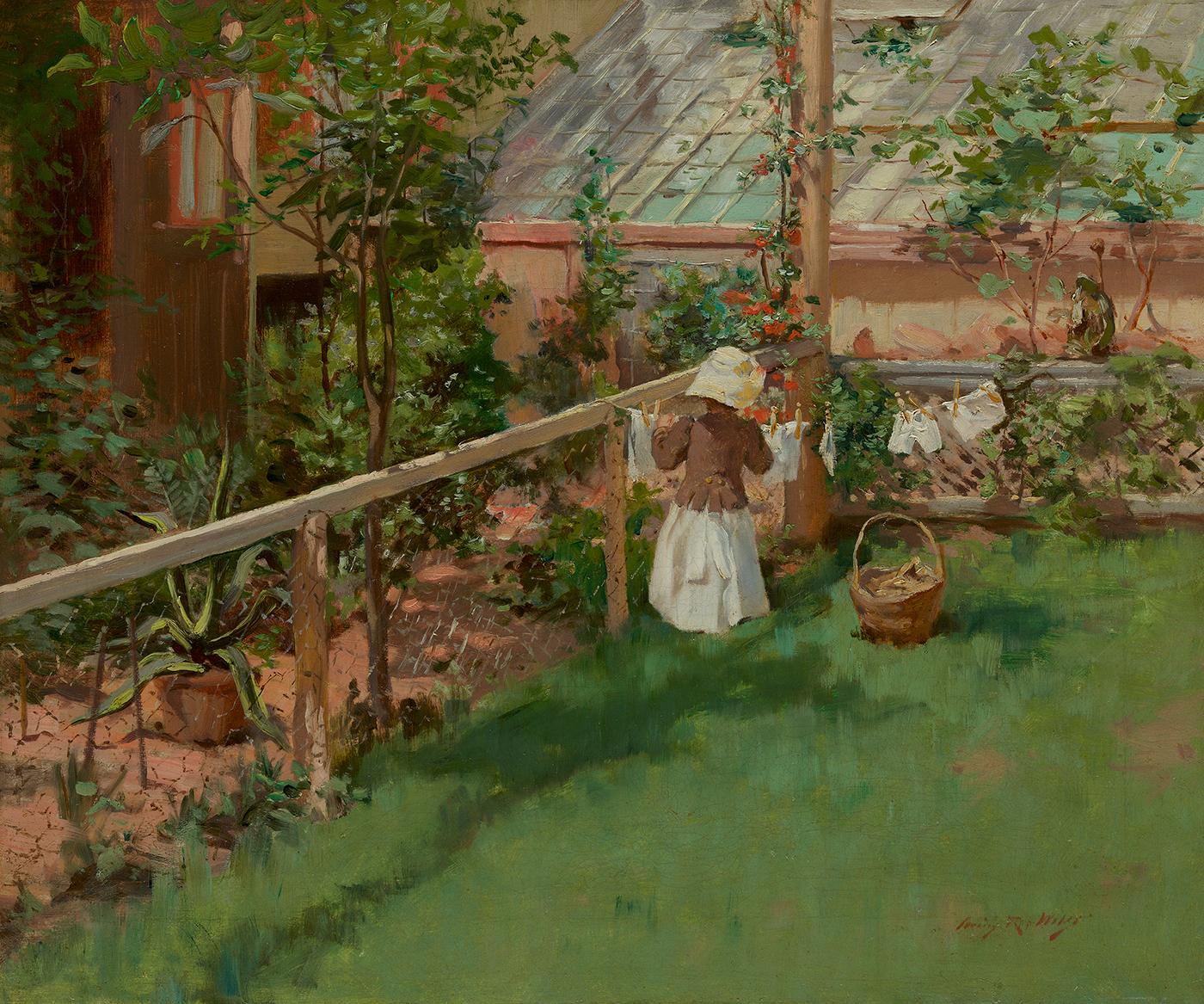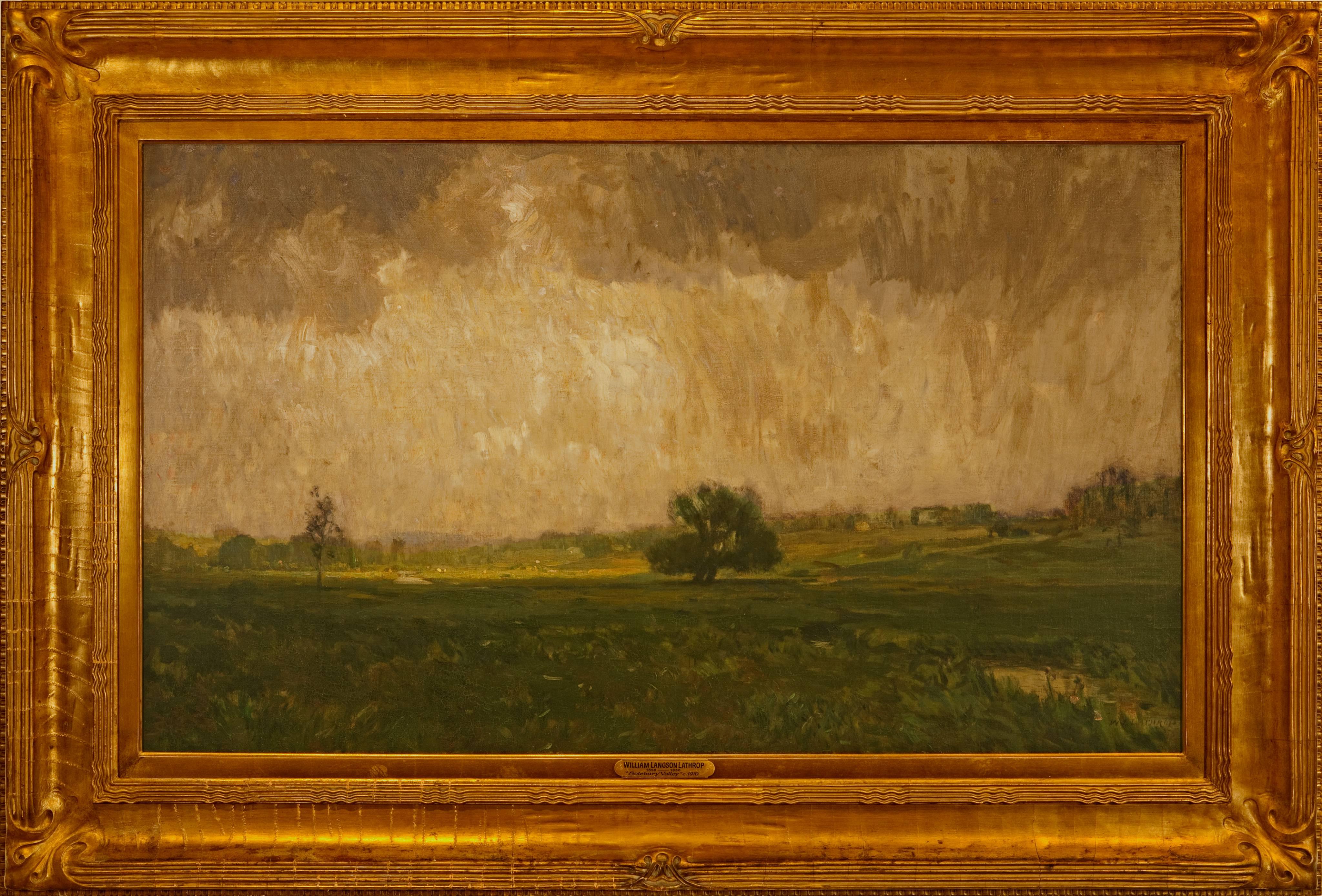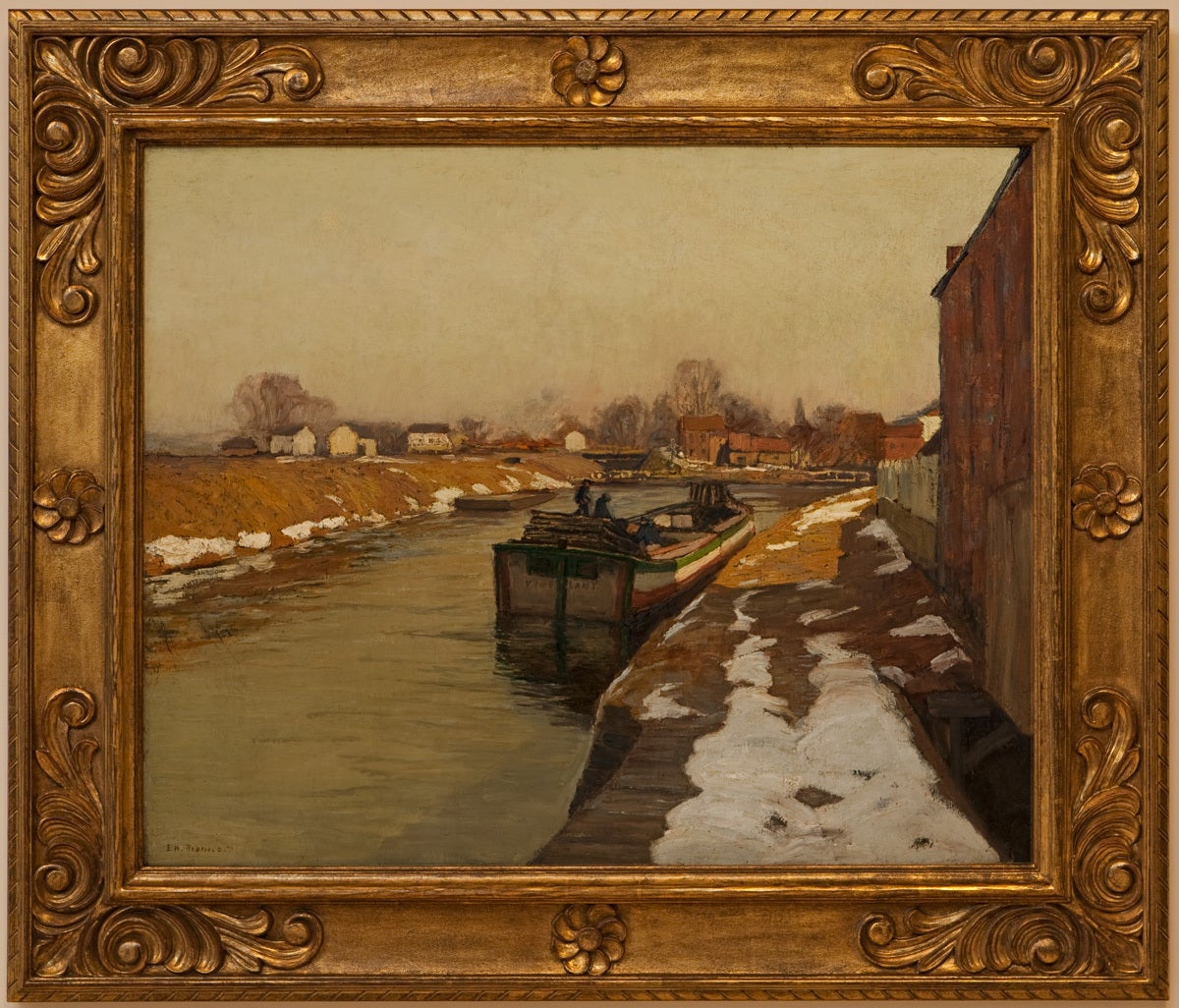Items Similar to Fishing Boats in St Ives Harbor, Cornwall. Luggers. Pilchards. Mackerel.Pilchard
Want more images or videos?
Request additional images or videos from the seller
1 of 24
Grant Tyson ReynardFishing Boats in St Ives Harbor, Cornwall. Luggers. Pilchards. Mackerel.Pilchard
About the Item
Grant Tyson Reynard.
American ( b.1887-1968 ).
Fishing Boats in St Ives Harbor, Cornwall
Oil on Canvas Board.
Signed lower left.
Image size 11 inches x 15.6 inches ( 28cm x 39.5cm ).
Frame size 14.2 inches x 18.1 inches ( 36cm x 46cm ).
Available for sale; this original oil painting is by the American artist Grant Tyson Reynard and dates from the period between 1912 and 1925.
The painting is presented and supplied in a sympathetic contemporary frame (which is shown in these photographs), and behind premium anti-reflective glass with UV Protection greater than 70% (Artglass AR 70™).
The painted surface has benefitted from cleaning and conservation, which was performed on our instruction, supervision and approval.
This antique painting is in very good condition, commensurate with its age. It wants for nothing and is supplied ready to hang and display.
The painting is signed lower left.
Grant Tyson Reynard was an accomplished American who gained an international reputation as a painter, printmaker, teacher and writer. He was born in Grand Island, Nebraska 20th October 1887 to Stephen Blackstone and Jennie Lynd Reynard. His father ran a music store and was also the manager of the Grand Island Opera House. As a youngster Grant would sketch the well-known people who visited the community. He had an early appreciation of music, sang well and originally trained as a pianist. However, he chose to pursue a career in the visual arts, studying at the Art Institute of Chicago, 1906-7, working in the days and studying at night, and then the Chicago Academy of Fine Arts 1908-1911.
In 1914 he moved to New Jersey to become a freelance illustrator, and attended summer classes in illustration organised by Harvey Dunn. It was here that he also met and became lifelong friends with John Steuart Curry, Charles Chapman, Mahonri Young and Harry Wickey, all prominent artists. He maintained a studio at Leonia, New Jersey for many years.
He quickly established himself as a top illustrator, contributing to major publications of his day, including Rednook Magazine (where he was also the Art Editor), The Saturday Evening Post, Harper’s Bazaar, Collier’s, Ladies’ Home Journal, Country Gentleman, McCalls and Cosmopolitan.
His increasing interest in painting and etching took him to the chief centres of study in Europe, especially Paris and London.
From 1926 through to 1937 he was a fellow of the MacDowell colony in Petersborough, New Hampshire. Reynard was elected a member of the National Academy of Design and the American Watercolor Society. He was the president of the Montclair Art Museum, and served six years on the faculty of the Grand Central School of Art, New York. He also conducted the Department of Art at Millbrook School, Millbrock, New York, and was artist-in-residence at Palo Duro School of Art in Texas. In 1955 Baldwin-Wallace College awarded him an honorary Doctor of Humane Letters (LHD).
Over the years Reynard’s focus shifted from illustration work to his own creative work, but in addition to producing his own art he also lectured in art and taught at several difference schools. Although he travelled extensively he remained loyal to his roots, returning to Nebraska every summer to conduct lectures and art classes in Omaha, Lincoln, Grand Island, Kearney and North Platte.
In 1941 Reynard published a book of his poems “Rattling Home for Christmas” which he also illustrated. He remained deeply involved in music, always being a skilled pianist, as well as literature, and his prints often depicted concert halls and museums.
Grant Reynard was married to Gwendolyn Crawford and they had two daughters. He died on 13th August 1968 in Leonia, New Jersey.
Today his work is included in the collections of the Library of Congress, Washington DC, Metropolitan Museum of Art, New York, the Smithsonian American Art Museum, and Sheldon Museum of Art, Lincoln, Nebraska. The Museum of Nebraska Art has the largest single collection of Grant Reynard’s art works.
© Big Sky Fine Art
This original oil painting depicts fishing boats in the port of St. Ives in the American Impressionism style. From the type of the vessels, it is likely that this was painted between 1912 and 1925. The town of St Ives in the far south-west of Cornwall has grown around its picturesque harbor since it was first settled in the 6th century. It was once one of the most important pilchard landing ports in Cornwall and at the time this painting was created, between 1912 and 1925, was still a significant port. Today the harbor is still thriving, although no longer so dependent on fishing. The painting perfectly captures the charm of this harbor, and the fishing vessels within it. Some of the vessels have a sail on their masts, reddish brown or white in color. Other vessels have bare masts. In the background, on the northern side of the harbor we see Smeaton’s Pier, which was constructed between 1767 and 1770. The pier was built by dumping rubble onto the seabed and then building the walls around this core. Smeaton’s Pier was originally 120 meters long with its elegant lighthouse sited at the end. However, in the 1890s the pier was extended to almost double this length and another lighthouse was added. We can see the three arches at the land end of the pier, which were added in during the 1890 modifications, and intended to allow the circulation of seawater and thus prevent the build-up of sand in the harbor.
- Creator:Grant Tyson Reynard (1887 - 1968, American)
- Dimensions:Height: 14.18 in (36 cm)Width: 18.12 in (46 cm)Depth: 0.99 in (2.5 cm)
- Medium:
- Movement & Style:
- Period:
- Condition:The painted surface has benefitted from cleaning and conservation. This antique painting is in very good condition, commensurate with its age. It wants for nothing and is supplied ready to hang and display.
- Gallery Location:Sutton Poyntz, GB
- Reference Number:1stDibs: LU489314187702
About the Seller
5.0
Platinum Seller
These expertly vetted sellers are 1stDibs' most experienced sellers and are rated highest by our customers.
Established in 2010
1stDibs seller since 2016
110 sales on 1stDibs
Typical response time: 1 hour
- ShippingRetrieving quote...Ships From: Sutton Poyntz, United Kingdom
- Return PolicyA return for this item may be initiated within 14 days of delivery.
More From This SellerView All
- Gaeaf, Cymru (Winter, Wales). Early 21st Century Welsh Landscape Oil Painting.By Gareth ParryLocated in Sutton Poyntz, DorsetGareth Parry. Welsh ( b.1951 ). After the Storm, Rocky Coast Oil on Canvas. Signed. Image size 19.7 inches x 23.8 inches ( 50cm x 60.5cm ). Frame size 24.6 inches x 28.5 inches ( 62...Category
21st Century and Contemporary Impressionist Landscape Paintings
MaterialsCanvas, Oil
- Before the Hot Day Brightens to Blue (Mevagissey Harbor, Cornwall). Original OilBy Gyrth RussellLocated in Sutton Poyntz, DorsetGyrth Russell. Canadian ( b.1892 - d.1970 ). Before the Hot Day Brightens to Blue (Mevagissey Harbor, Cornwall). Oil on Canvas. Signed. Image size 22.4 inches x 34.8 inches ( 57cm x 88.5cm ). Frame size 28.5 inches x 40.6 inches ( 72.5cm x 103cm ). Available for sale; this original oil painting is by Gyrth Russell and dates from post WWII. The painting is presented and supplied in a 1960s frame (which is shown in these photographs). The painted surfaces have benefitted from cleaning and conservation, which took place on our instruction, supervision and approval. This vintage painting is now in very good condition, commensurate with its age. It wants for nothing and is supplied ready to hang and display. The painting is signed lower right. Previously with the Howard Roberts Gallery, Cardiff. Considered one of the best coastal painters of the 20th century, Gyrth Russell was born in Halifax, Nova Scotia in April 1892. He was the youngest of 8 children. His father was a Canadian MP and a Supreme High Court Judge for Nova Scotia. At the age of fourteen, Russell began his artistic career at Halifax School of Art, and quickly graduated to the School of Art at Boston, Massachusetts. His first job was as a draughtsman in the Public Works Department of Canada, in Halifax. It was during this period he saw and sketched the cable ship Mackay Bennett returning to her Halifax Station, her decks piled high with coffins containing bodies found after the Titanic Disaster. In 1911 Russell left Canada to study at the Academie Julian and Academie Calorossi in Paris. In 1914 at the outbreak of War, he left France for London where he was commissioned, under the command of Lord Beaverbrook, as an official War Artist for the Canadian Sector, and spent most of 1918 in Northern France painting the landscapes and coasts travelled by the Canadian military during the conflict. During the course of the First World War he worked with amongst others, Augustus John, William Orpen & Frank Brangwyn, who greatly influenced him. Many of his earliest works are of landscapes and coasts travelled by the Canadian military in the conflict. During the War Russell also made etchings and poster prints for sale to help popularize and support the war effort abroad. He took part in the Canadian War Memorial Exhibition in London in 1919. Between the Wars, Russell earned his living as an artist in film studios, designing Railway Posters, Lecturing and Writing. He also illustrated books on the geography of Nova Scotia and Western Britain. Russell enjoyed considerable success between the Wars, exhibiting extensively at the major galleries, and was elected to membership of the Royal Society of British Artists, the Royal Institute of Painters and Watercolorists, the Royal Institute of Oil Painters and the Royal Society of Marine Artists as well as being an active member of the Langham...Category
Mid-20th Century Impressionist Landscape Paintings
MaterialsCanvas, Oil
- Ness Harbor, Butt of Lewis, Scotland. Hebrides. Western Isles LandscapeBy Gyrth RussellLocated in Sutton Poyntz, DorsetGyrth Russell. Canadian ( b.1892 - d.1970 ) Ness Harbor, Butt of Lewis, Outer Hebrides. Oil on canvas. Signed. Image size 15.6 inches x 23.6 inches ( 39.5cm x 60cm ). Frame size 21 inches x 29.1 inches ( 53.5cm x 74cm ). Available for sale; this original oil painting is by Gyrth Russell and dates from the...Category
Mid-20th Century Impressionist Landscape Paintings
MaterialsCanvas, Oil
- WWII Wartime Painting Rouen after Bombing & Bombardment.Cathedral & River SeineLocated in Sutton Poyntz, DorsetPaul-Jean Anderbouhr. French ( b.1909 - d.2006 ). The Ravages of War on Rouen, 1944. Oil on Canvas. Signed lower left. Image size 23.2 inches x 28.5 inches ( 59cm x 72.5cm ). Frame s...Category
Mid-20th Century Impressionist Landscape Paintings
MaterialsCanvas, Oil
- Setting Pots.Welsh Seascape Coastal Marine. Offshore Sea Fishing Lobster & CrabBy Gareth ParryLocated in Sutton Poyntz, DorsetGareth Parry. Welsh ( b.1951 ). Setting Pots Oil on Canvas. Signed. Image size 24 inches x 24 inches ( 61cm x 61cm ). Frame size 30.5 inches x 30.5 inches ( 77.5cm x 77.5cm ). Avai...Category
2010s Impressionist Landscape Paintings
MaterialsCanvas, Oil
- Ben Nevis from Loch Eil. Impasto.Scottish Highlands.Grampian Mountains. ScotlandBy Nancy BaileyLocated in Sutton Poyntz, DorsetNancy Bailey. English ( b.1913 - d.2012 ). Ben Nevis from Loch Eil, 1978. Oil on Canvas. Signed. Image size 19.3 inches x 39.4 inches ( 49cm x 100cm ). Frame size 24.8 inches x 44.9...Category
Mid-20th Century Impressionist Landscape Paintings
MaterialsCanvas, Oil
You May Also Like
- At the ClotheslineBy Irving Ramsey WilesLocated in New York, NYSigned lower right: Irving R. WilesCategory
Late 19th Century American Impressionist Landscape Paintings
MaterialsCanvas, Oil
- "Alley Fiends"By John R. GrabachLocated in Lambertville, NJJim’s of Lambertville is proud to offer this artwork by: John R. Grabach (1886 - 1981) John Grabach was a highly regarded New Jersey artist, teacher, and author of the classic text...Category
1930s American Impressionist Landscape Paintings
MaterialsCanvas, Oil
- "Forest Strongholds"By John F. CarlsonLocated in Lambertville, NJSigned lower right. Complemented by a hand carved and gilt frame. Exhibited at the National Academy of Design, 1928Category
20th Century American Impressionist Landscape Paintings
MaterialsCanvas, Oil
- "Solebury Valley"By William Langson LathropLocated in Lambertville, NJSigned lower right. Complemented by a period frame. William L. Lathrop (1859-1938) Deemed “Father of the New Hope Art Colony”, William Langson Lathrop was born in Warren, Illinois. He was largely self-taught, having only studied briefly with William Merritt Chase in 1887, at the Art Students League. Lathrop first moved east in the early 1880s, and took a job at the Photoengraving Company in New York City. While there, he befriended a fellow employee, Henry B. Snell. The two men became lifelong friends and ultimately, both would be considered central figures among the New Hope Art Colony. Lathrop's early years as an artist were ones of continuing struggle. His efforts to break through in the New York art scene seemed futile, so he scraped enough money together to travel to Europe with Henry Snell in1888. There he met and married an English girl, Annie Burt. Upon returning to New York, he tried his hand at etching, making tools from old saw blades...Category
1910s American Impressionist Landscape Paintings
MaterialsCanvas, Oil
- Winter MoonlightBy George William SotterLocated in Lambertville, NJsigned lower rightCategory
1910s American Impressionist Landscape Paintings
MaterialsCanvas, Oil
- "The Canal"By Edward Willis RedfieldLocated in Lambertville, NJJim’s of Lambertville is proud to offer this artwork. Signed lower left. Complemented by a hand carved and gilt frame. Illustrated in "Edward Redfield: Just Values and Fine Seeing" by Constance Kimmerle and the Pennsylvania Academy of the Fine Arts's Exhibition of Paintings by Edward Redfield (April 17 to May 16, 1909) brochure Edward Willis Redfield (1869 - 1965) Edward W. Redfield was born in Bridgeville, Delaware, moving to Philadelphia as a young child. Determined to be an artist from an early age, he studied at the Spring Garden Institute and the Franklin Institute before entering the Pennsylvania Academy from 1887 to 1889, where he studied under Thomas Anshutz, James Kelly, and Thomas Hovenden. Along with his friend and fellow artist, Robert Henri, he traveled abroad in 1889 and studied at the Academie Julian in Paris under William Bouguereau and Tony Robert-Fleury. While in France, Redfield met Elise Deligant, the daughter of an innkeeper, and married in London in 1893. Upon his return to the United States, Redfield and his wife settled in Glenside, Pennsylvania. He remained there until 1898, at which time he moved his family to Center Bridge, a town several miles north of New Hope along the Delaware River. Redfield painted prolifically in the 1890s but it was not until the beginning of the twentieth century that he would develop the bold impressionist style that defined his career. As Redfield’s international reputation spread, many young artists gravitated to New Hope as he was a great inspiration and an iconic role model. Edward Redfield remained in Center Bridge throughout his long life, fathering his six children there. Around 1905 and 1906, Redfield’s style was coming into its own, employing thick vigorous brush strokes tightly woven and layered with a multitude of colors. These large plein-air canvases define the essence of Pennsylvania Impressionism. By 1907, Redfield had perfected his craft and, from this point forward, was creating some of his finest work. Redfield would once again return to France where he painted a small but important body of work between 1907 and 1908. While there, he received an Honorable Mention from the Paris Salon for one of these canvases. In 1910 he was awarded a Gold Medal at the prestigious Buenos Aires Exposition and at the Panama-Pacific Exposition of 1915 in San Francisco, an entire gallery was dedicated for twenty-one of his paintings. Since Redfield painted for Exhibition with the intent to win medals, his best effort often went into his larger paintings. Although he also painted many fine smaller pictures, virtually all of his works were of major award-winning canvas sizes of 38x50 or 50x56 inches. If one were to assign a period of Redfield’s work that was representative of his “best period”, it would have to be from 1907 to 1925. Although he was capable of creating masterpieces though the late 1940s, his style fully matured by 1907 and most work from then through the early twenties was of consistently high quality. In the later 1920s and through the 1930s and 1940s, he was like most other great artists, creating some paintings that were superb examples and others that were of more ordinary quality. Redfield earned an international reputation at a young age, known for accurately recording nature with his canvases and painting virtually all of his work outdoors; Redfield was one of a rare breed. He was regarded as the pioneer of impressionist winter landscape painting in America, having few if any equals. Redfield spent summers in Maine, first at Boothbay Harbor and beginning in the 1920s, on Monhegan Island. There he painted colorful marine and coastal scenes as well as the island’s landscape and fishing shacks. He remained active painting and making Windsor style furniture...Category
Early 1900s American Impressionist Landscape Paintings
MaterialsCanvas, Oil





